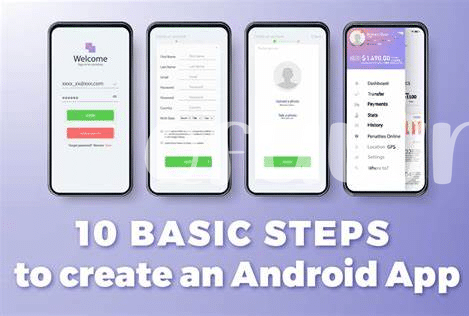
- Tackle the Memory Hogs: Monitor Ram Usage 🐗
- Compress Images Efficiently: Optimize Resources 🌄
- Code Wisely: Leverage Android Profilers 🛠️
- Keep It Svelte: Trim Your App’s Layout 📏
- Offline First: Reduce Dependency on Network 📶
- Embrace Lazy Loading: Pace Your Content Display 🚀
Table of Contents
ToggleTackle the Memory Hogs: Monitor Ram Usage 🐗
Android developers often face the dreaded scenario of an app guzzling more RAM than a festive hog on acorns. Like a silent beast in the shadows, inefficient memory usage can creep up, grinding user experience to a halt and tarnishing your app’s reputation. As vigilant stewards of our code, we must wade into the fray, armed with the Android Studio’s formidable set of memory monitoring tools, to track down and root out these memory hogs. With a watchful eye on real-time memory statistics and diving deep into heap analysis, we can isolate those RAM gluttons, streamline allocations, and recapture that smooth, responsive performance users love and expect. Analyze, optimize, and test—these are the mantras of the memory-conscious developer. These strategic moves ensure our digital creations thrive in the wild jungle of devices, bearing the fruit of enhanced performance while proving that a shoestring budget need not tether innovation.
| Step | Tool | Action |
|---|---|---|
| 1 | Android Studio | Monitor real-time RAM usage |
| 2 | Memory Profiler | Perform heap analysis |
| 3 | GC Logs | Identify unnecessary allocations |
Compress Images Efficiently: Optimize Resources 🌄
As developers, when we embark on the pilgrimage through the pixelated paradises of our Android apps, the hefty weight of bitmap images can almost make us buckle at the knees. Imagine each pixel as a little byte with an unquenchable thirst for space; it’s like inviting a troupe of sumo wrestlers to a canoe already brimming with eager passengers. The solution? Squeeze them down to size without the audience noticing something’s amiss. By employing algorithms that intelligently trim the flab off your images, the magic of compression shrinks file sizes with minimal quality loss. Quality and speed need not battle each other; they can waltz together in harmony, offering users a feast for their eyes while sparing the memory buffet. Whether it’s PNGs or JPEGs sitting pretty in your app, serving them in a more digestible format will have your users swiping through content smoother than a skater on ice. And when they wonder about keeping things under lock and key, nudging them toward enlightening reads on how to lock apps on android without app, might just be the cherry on top. So, embrace this march towards a leaner, meaner app that both your server and users will thank you for – and all without the need to reach for your wallet.
Code Wisely: Leverage Android Profilers 🛠️
Unleashing the full potential of your Android application hinges on efficient coding — a realm where the power of Android profilers comes into play. These indispensable tools are akin to a surgeon’s scalpel, slicing through the nebulous fog to highlight the nitty-gritty of CPU, memory, and network usage in real-time. Imagine diagnosing performance bottlenecks with precision, identifying those rogue lines of code that, once optimized, can significantly rev up your app’s speed. Like an expert detective 🕵️♂️, you scour through the data, piecing together patterns that spell the difference between sluggishness and sleek performance. What’s more, with the profilers’ guidance, you adopt smarter coding practises: perhaps offloading intensive computations to background threads, or leveraging the superpowers of Kotlin’s coroutines for more efficient asynchronous work. And let’s not forget the memory leaks — those silent assassins of app health. By tracking down these elusive culprits early, you preempt a cascade of crashes and discontent, ensuring users remain engaged. So grab your profiler, it’s time to fine-tune your masterpiece without the cost weighing down your spirit.
Keep It Svelte: Trim Your App’s Layout 📏
When delving into the art of digital minimalism, consider your application’s layout like the floor plan of a tiny yet efficient apartment – each component should add value and occupy space judiciously. Too often, developers cram their user interfaces with all the bells and whistles they can think of, which not only clutters the user’s visual space but can also hamper functionality and speed 📏. It’s about striking that perfect balance between aesthetics and performance. Seperate non-essential elements from those that truly matter to your users. Streamlining navigation menus, consolidating similar functions, and avoiding redundant views not only offers a cleaner, more intuitive user experience but also helps in reducing your app’s memory footprint – a win-win for both the app connoisseur and their device.
For those looking to secure aspects of their app’s interface, knowing how to lock apps on android without app can be invaluble. It preserves user privacy without compromising on the sleekness of the design. As developers, approaching the design with an ‘offline-first’ mentality can pay dividends; think compress to impress, and cache effectively to ensure your content is always ready for the spotlight, even when the network isn’t 🚀. Remember, you don’t need deep pockets to keep your app running like a well-oiled machine; sometimes, the smartest move is simplifying the complex and trimming the fat for a lean, mean, performing machine.
Offline First: Reduce Dependency on Network 📶
In our modern digital odyssey, an “offline first” approach acts as a bridge to impeccable user experience, even when the capricious waves of network connectivity threaten to disrupt the journey. Crafting an app with a robust offline mode, akin to preparing a ship for the fiercest of seas, ensures that your users remain content and engaged, regardless of internet availability. By caching essential data 📁 and leveraging browser databases like IndexedDB or local storage, your app can access critical information instantaneously, sans an active connection. This magicians’ trick of keeping users blissfully unaware of network issues not only enhances the app’s responsiveness but also conservatively sips on the user’s data plan, offering a twofold boon.
Consider the anticipation of flipping through a well-loved book 📚 without the barrier of load times—a harmony between technology and tradition that your app can mirror. By implementing intelligent syncing strategies, updates occur in the background, gracefully merging with the local content once the device reconnects to the grid. This seamless transition emphasizes efficiency and is sure to keep your users anchored to your app, loyalty solidified amidst the ebbs and flows of connectivity.
| Strategy | Description | Benefits |
|---|---|---|
| Caching | Store relevant data locally on the device. | Quick access and reduced data usage. |
| Browser Databases | Use mechanisms like IndexedDB for large-scale data storage. | Enables complex data handling offline. |
| Background Syncing | Sync with online servers only when a connection is available. | Maintains up-to-date information without disrupting the user experience. |
In such a builder’s realm, an offline strategy is no mere afterthought but the cornerstone of app development—shaping a sanctuary for users come rain or shine in the temperamental climate of internet connectivity. The finesse of your craft lies not just in what’s visible but how it stands resilent against the unseen, ensuring your app remains an indispensable companion through the fickle winds of the digital era.
Embrace Lazy Loading: Pace Your Content Display 🚀
In the digital cosmos, where every millisecond can be a make-or-break moment for user retention, initiating a deceptively simple strategy like lazy loading becomes a game-changer 🚀. Imagine you’re at a sumptuous buffet: instead of loading your plate with an overwhelming variety, you pick just enough to savor in the moment, returning for more as your appetite demands. That’s the essence of lazy loading—serving up app content in digestible chunks, thusly ensuring swift, responsive interactions that keep users engaged and satisfied.
By deferring the loading of non-critical resources at startup, your app feels zippier, as it doesn’t wastefully choke on data that the user might not even glance at. This not only paces the content display in harmony with user actions but also conserves precious bandwidth—an act of grace for those on sketchy connections or stringent data plans 📶. As they scroll, they recieve (the beautifully fluid motion of content that seems to emerge out of thin air, breathing life into the user experience with the elegance of a well-rehearsed ballet. Indubitably, this technique not only maximizes app performance but also scales up user satisfaction, all without costing a dime.




